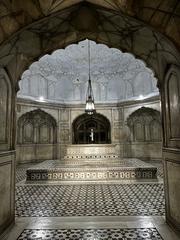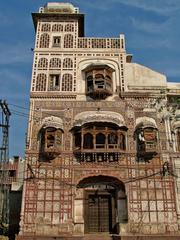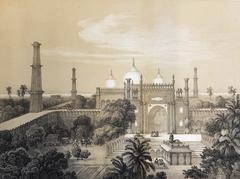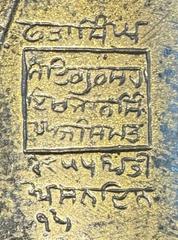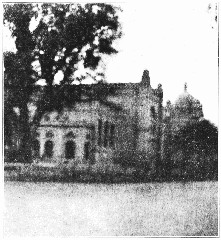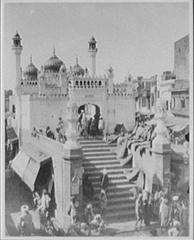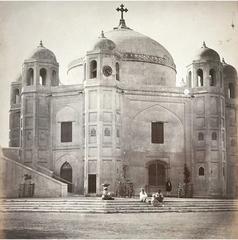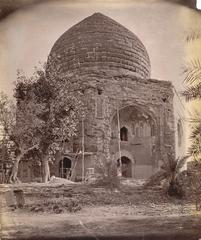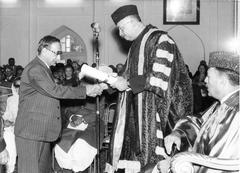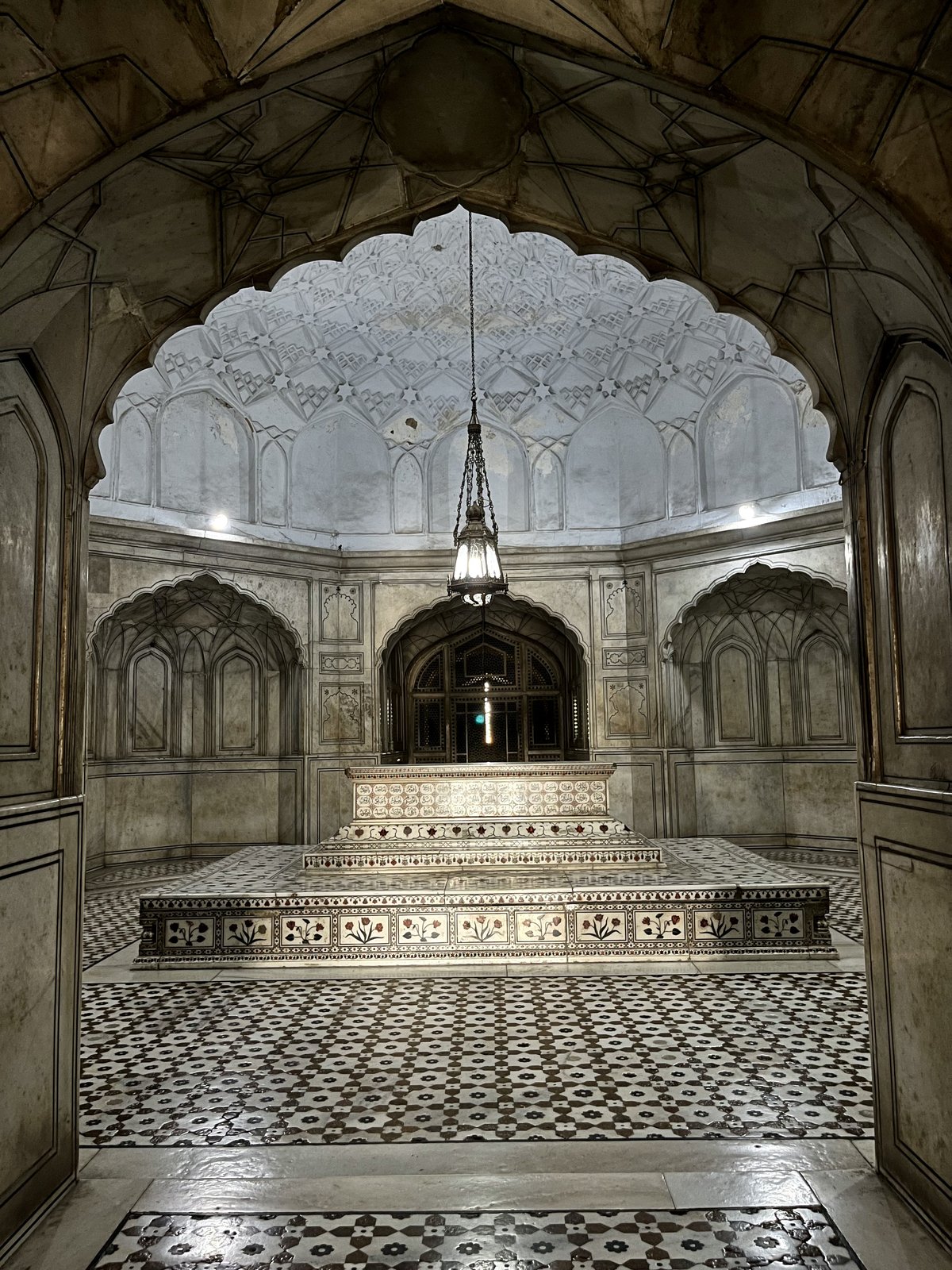
Tomb of Jahangir Lahore: Visiting Hours, Tickets, and Historical Significance
Date: 14/06/2025
Introduction
The Tomb of Jahangir in Lahore, Pakistan, stands as an enduring symbol of Mughal architectural excellence and cultural heritage. Situated in Shahdara Bagh on the banks of the River Ravi, this mausoleum honors Emperor Jahangir (r. 1605–1627) and represents a period of artistic refinement in the Mughal Empire. Commissioned by his son Shah Jahan and attributed to Ustad Ahmad Lahauri—the architect of the Taj Mahal—the tomb exemplifies Mughal funerary architecture with its harmonious blend of red sandstone, white marble, intricate pietra dura, and calligraphy. Nestled within a classical charbagh (four-part) garden, the complex also includes significant monuments such as Akbari Sarai, and the tombs of Nur Jahan and Asif Khan. Today, the site invites visitors to explore not only its architectural grandeur but also its rich spiritual and historical legacy.
This guide provides a detailed overview of the Tomb of Jahangir’s history, architecture, cultural significance, and practical information for visitors—including visiting hours, ticket prices, accessibility, and tips for making the most of your trip. It also highlights nearby attractions to help you plan a comprehensive Lahore heritage itinerary. For further details, see sources such as Letstravel.pk and Wikipedia.
Table of Contents
- Historical Background and Cultural Significance
- Cultural and Artistic Importance
- Architecture and Layout
- Visitor Information
- Guided Tours and Interpretation
- Nearby Attractions and Suggested Itineraries
- Frequently Asked Questions (FAQ)
- Visual Media Suggestions
- Conclusion
- References and Further Reading
Historical Background and Cultural Significance
Jahangir’s Reign and Legacy
Emperor Jahangir, born Prince Salim in 1569, became the fourth Mughal emperor in 1605. His reign, lasting until 1627, was characterized by stability, prosperity, and remarkable patronage of the arts and architecture. After his death near Rajauri in Kashmir in 1627, Jahangir’s body was transported to Lahore and buried in Dilkusha Garden—a location he and his consort, Nur Jahan, cherished (letstravel.pk, wikipedia).
Construction and Architectural Patronage
The construction of Jahangir’s tomb began in 1627 by order of Shah Jahan and took roughly a decade to complete, with a cost estimated at Rs 10 lakh—a significant sum at the time. Ustad Ahmad Lahauri, renowned for designing the Taj Mahal, is credited with the tomb’s unique layout and artistic detailing (letstravel.pk). The tomb became a model for subsequent Mughal funerary monuments.
Architectural Features and Persian Influences
The tomb’s design reflects a fusion of Mughal and Safavid Persian influences, shaped in part by Nur Jahan’s Persian heritage. The charbagh garden, geometric layouts, and use of pietra dura and calligraphy are hallmarks of this synthesis (wikipedia). The absence of a central dome—a rarity among Mughal mausoleums—was reportedly Jahangir’s own wish.
The Complex and Its Setting
Located in Shahdara Bagh, northwest of Lahore’s Walled City, the tomb serves as the focal point of Dilkusha Garden. The site is surrounded by significant structures including Akbari Sarai (a Mughal caravanserai), and the tombs of Nur Jahan and Asif Khan, all arranged along an east-west axis. The garden’s original design, water features, and monumental gates underscore the Mughal vision of paradise (letstravel.pk, wikipedia).
Cultural and Artistic Importance
Mughal Artistic Achievement
The Tomb of Jahangir is lauded for its harmonious proportions, fine inlay work, and lush gardens, encapsulating the Mughal empire’s artistic vision. Often called the “finest ornament of Lahore,” the tomb stands among South Asia’s most distinguished monuments after the Taj Mahal (visitlahore.com).
Preservation and Legacy
The site experienced periods of neglect during Sikh and British rule, but restoration and conservation have been prioritized since Pakistan’s independence. Now protected under the Federal Antiquities Act and listed on UNESCO’s tentative World Heritage list, ongoing efforts aim to safeguard its legacy (wikipedia; visitlahore.com).
Spiritual Symbolism
The charbagh layout, Quranic inscriptions, and floral motifs throughout the tomb express Islamic concepts of paradise. Its status as a dynastic mausoleum, with the tombs of Nur Jahan and Asif Khan nearby, enhances its spiritual and historical significance. The tomb has also been featured on Pakistan’s currency and postage stamps, reflecting its role in national identity (wikipedia).
Ensemble with Adjacent Monuments
The combination of Jahangir’s tomb with Akbari Sarai, and the tombs of Nur Jahan and Asif Khan, provides a unique example of Mughal funerary architecture and garden design, deepening the visitor’s appreciation of Lahore’s Mughal heritage (wikipedia).
Architecture and Layout
Charbagh Garden and Site Plan
The tomb complex is set within a 55-acre charbagh (four-part) garden, divided by paved walkways and water channels representing the rivers of paradise. The site’s symmetry and geometric precision are defining features.
Mausoleum: Exterior and Interior
The mausoleum, built of red sandstone with marble inlays, measures approximately 84 meters square. Uniquely, it lacks a central dome and is instead crowned by four 30-meter minarets at each corner, each decorated with marble chhatris and bands of inlay. The rooftop is accessible, offering views of the gardens and intricate marble work. Inside, Jahangir’s cenotaph is inscribed with Quranic verses and surrounded by a marble lattice screen.
Waterworks and Garden Features
The garden’s original water system was ingeniously engineered, with fountains and pools in each quadrant. These features, along with brick pathways and shaded areas, embody the Mughal ideal of paradise on earth.
Associated Structures
- Akbari Sarai: A caravanserai providing accommodation for travelers and caretakers, notable for its arcaded rooms and mosque.
- Tomb of Asif Khan: An octagonal tomb honoring Jahangir’s brother-in-law, showcasing distinctive Mughal design.
- Tomb of Nur Jahan: A smaller mausoleum for Jahangir’s influential wife, known for its many windows and natural light.
- Baradari and Gates: The site includes a historic pavilion (baradari) and monumental gates, especially the ornate southern gate, all enclosed within decorated walls.
Visitor Information
Visiting Hours and Tickets
- Opening Hours: The Tomb of Jahangir is generally open daily from 8:00 AM to 6:00 PM, though some sources note 9:00 AM to 7:00 PM. Hours may vary on public holidays or during special events (letstravel.pk; visitlahore.com; TravelSetu).
- Ticket Prices: Entry is affordable, with rates around PKR 50 for Pakistani nationals and PKR 300 for international visitors. Children under 12 often enter free. Always bring cash, as card payments may not be accepted. Check current pricing at the ticket counter or on official sites.
- Guided Tours: Local guides offer tours in English and Urdu. Self-guided options include informational plaques and QR codes.
Accessibility and On-site Facilities
- Location: Situated in Shahdara Bagh, about 7 km from Lahore’s city center. Accessible by car, taxi, or public transport. Ample parking is available.
- Accessibility: Most of the site has paved pathways and some ramps, making it generally accessible for those with limited mobility. Some areas may have uneven surfaces due to the site’s historical nature.
- Facilities: Clean restrooms, shaded seating, and souvenir stalls are available. Vendors offer bottled water and snacks near the entrance; for full meals, head to nearby city food streets.
- Photography: Allowed in gardens and exterior areas. Flash photography and tripods may be restricted inside the mausoleum.
Tips for Visitors
- Visit during cooler months (October–March) for comfortable weather.
- Arrive early or late in the day to avoid crowds and harsh sunlight.
- Wear modest, comfortable clothing and walking shoes.
- Carry bottled water and small denominations of Pakistani rupees.
- Respect the sanctity of the site—avoid touching artworks and maintain quiet in mausoleum areas.
Guided Tours and Interpretation
Guided tours, available in English and Urdu, enrich the experience with historical context and architectural details. Self-guided tours using informational plaques and QR codes are also available. For a deeper dive into Mughal history, consider arranging a virtual or augmented reality tour (TravelSetu).
Nearby Attractions and Suggested Itineraries
- Tomb of Nur Jahan & Tomb of Asif Khan: Adjacent Mughal-era mausoleums with their own unique stories and architecture.
- Akbari Sarai: Historic caravanserai within the complex.
- Shalimar Gardens: UNESCO-listed Mughal gardens about 8 km away (Pakistan Analysis).
- Lahore Fort & Badshahi Mosque: Iconic Mughal landmarks roughly 10 km away, near the Walled City (JBMS.pk).
- Data Darbar: Major Sufi shrine in central Lahore.
- Lahore Museum: Rich collections of Mughal, Sikh, and colonial artifacts.
- Walled City of Lahore: Historic core featuring the Delhi Gate and Anarkali Bazaar.
- Minar-e-Pakistan: National monument in Iqbal Park.
- Sheesh Mahal: Palace of Mirrors within Lahore Fort.
- Chauburji: Distinctive Mughal gateway.
- Jilani Park: Lush city park.
- Liberty Market & Anarkali Bazaar: Popular shopping destinations.
- MM Alam Road Food Street: Renowned for traditional Lahore cuisine.
- Wagah Border: Witness the flag-lowering ceremony, about 30 km from central Lahore (Laure Wanders).
Frequently Asked Questions (FAQ)
Q: What are the Tomb of Jahangir’s visiting hours?
A: Open daily, typically 8:00 AM to 6:00 PM. Check before visiting as hours may vary.
Q: How much are the tickets?
A: PKR 50 for locals, PKR 300 for foreigners, with discounts for children and students.
Q: Is the site wheelchair accessible?
A: Most areas are accessible via paved pathways; some uneven surfaces exist.
Q: Are guided tours available?
A: Yes, in English and Urdu; self-guided and virtual options are available.
Q: Is photography allowed?
A: Permitted in gardens and exteriors; restrictions apply inside the mausoleum.
Q: What other historical sites are nearby?
A: Shalimar Gardens, Lahore Fort, Badshahi Mosque, and more.
Visual Media Suggestions
- High-resolution images of the tomb’s façade, gardens, pietra dura, and cenotaph.
- Short video tours of the complex and gardens.
- Interactive maps showing the tomb’s location relative to other Lahore landmarks.
- Alt text recommendations: “Tomb of Jahangir visiting hours,” “Mughal architecture Lahore,” “Shahdara Bagh garden.”
Conclusion
The Tomb of Jahangir is a monument of extraordinary beauty and historical depth, offering an immersive experience into Mughal artistry and Lahore’s rich heritage. With its lush gardens, intricate architecture, and proximity to other cultural landmarks, it remains a must-visit destination for travelers and history enthusiasts alike. Plan your visit with knowledge of opening hours, ticketing, and nearby attractions, and consider a guided tour to gain deeper insight into this UNESCO-listed treasure.
For more information on Lahore’s historical sites, download the Audiala app, explore related articles, and follow us on social media for travel updates and tips.
References and Further Reading
- Letstravel.pk: The Tomb of Mughal Emperor Jahangir
- Wikipedia: Tomb of Jahangir
- VisitLahore.com: Jahangir’s Tomb
- TravelSetu: Tomb of Jahangir Tourism
- Travelot.pk: Tomb of Jahangir
- Pakistan Analysis: Best Tourist Places in Lahore
- JBMS.pk: Best Places to Visit in Lahore
- Laure Wanders: Best Places to Visit in Lahore
